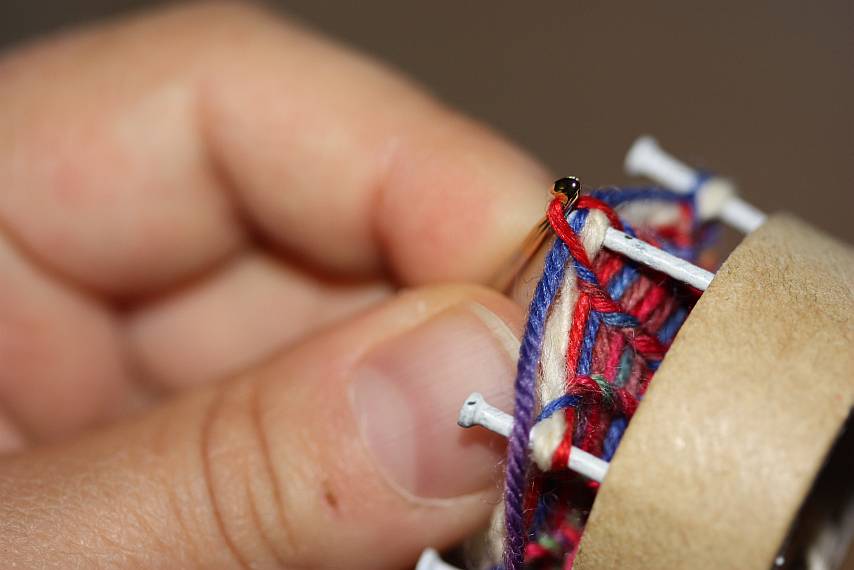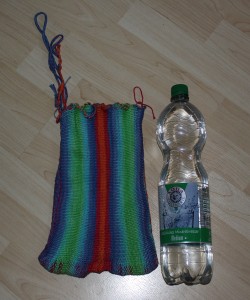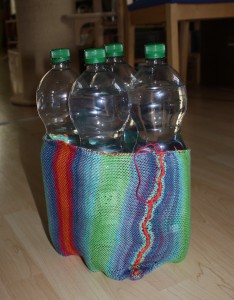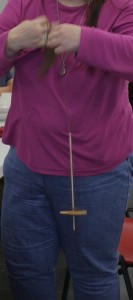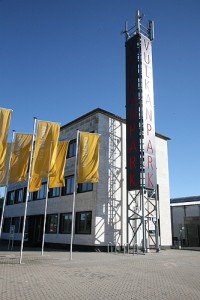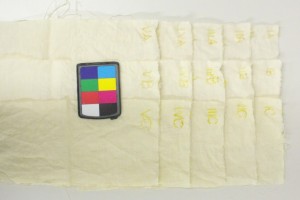So... as seen yesterday, working compound knitting (or double-depth knitting) on a dolly or similar thing is very easy. Let's add some challenge - off to the needles with this!
Ruth Gilbert (who is one of the reasons I started knitting a few years back) brought instructions with her to the Textile Forum, taken from Marianne Erikson's book Textiles in Egypt 200-1500 A.D. in Swedish Museum Collections, Gothenburg: Rohsska Museet. You can find them on p. 235, fig. 23. Or look at the following knitting pictures, where I'm following her instructions.
You're always working with a pair of stitches (so cast on double the amount you want to work).
Transfer both stitches to the right needle.
[caption id="attachment_1929" align="alignnone" width="422"]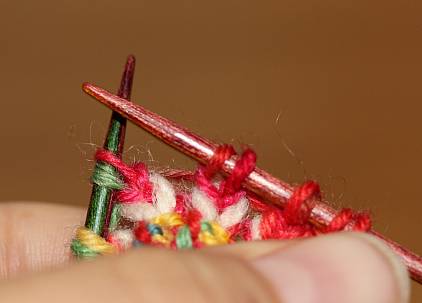 Unworked stitches on the right needle...
Unworked stitches on the right needle...
Insert left needle into the right stitch, loop yarn around right needle, and pull yarn and stitch through.
[caption id="attachment_1928" align="alignnone" width="420"]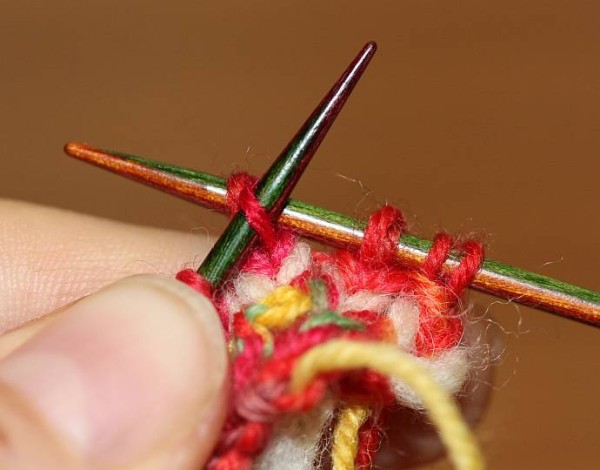 Insert left needle into the right stitch...
Insert left needle into the right stitch...
[caption id="attachment_1936" align="alignnone" width="420"]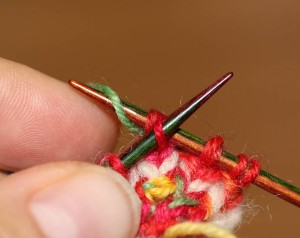 ...loop yarn around...
...loop yarn around...
[caption id="attachment_1935" align="alignnone" width="422"]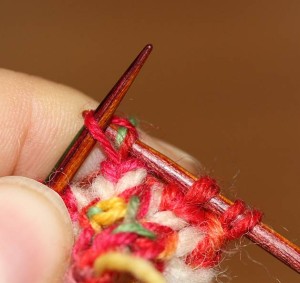 ... and pull through.
... and pull through.
Note the alignment of the stitches: The older stitch lies to the right, its right leg behind the needle; the new stitch lies to the left, its right leg in front of the needle (as is the customary orientation in Western European knitting).
[caption id="attachment_1934" align="alignnone" width="300"]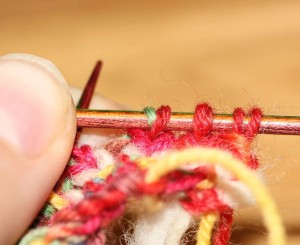 Stitch alignment.
Stitch alignment.
For the return row (if you are knitting flat), you insert the left needle into the second stitch on the right needle,
[caption id="attachment_1933" align="alignnone" width="300"]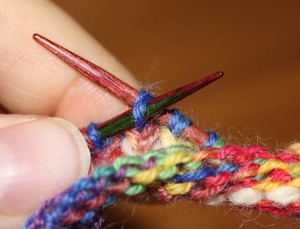 Insert left needle into right stitch on right needle...
Insert left needle into right stitch on right needle...
loop the yarn around the right needle, and draw yarn and the stitch on the right needle through.
[caption id="attachment_1932" align="alignnone" width="300"]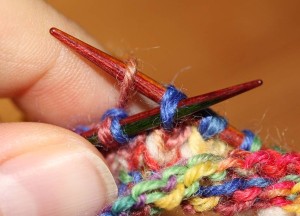 ... loop yarn around...
... loop yarn around...
[caption id="attachment_1931" align="alignnone" width="300"]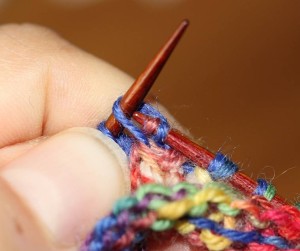 ...and draw through.
...and draw through.
The older stitch now lies again to the right of the pair, with its right leg in the back; the old stitch on the right has its right leg in the front.
[caption id="attachment_1930" align="alignnone" width="300"]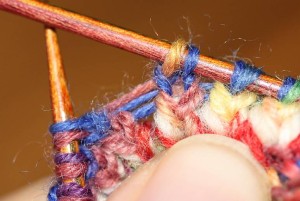 Stitch alignment. New stitch to the left, old to the right.
Stitch alignment. New stitch to the left, old to the right.
Now transfer both stitches to the left needle and continue.
These instructions totally work - and they are a lot of slipping stitches. It gets less slippery if you work in the round (where you only use the instructions for the first row, working from left to right), but it still feels... awkward.
Is there a better way to do it? One more efficient, and involving less slipping? We'll see. Later this week.
Ruth Gilbert (who is one of the reasons I started knitting a few years back) brought instructions with her to the Textile Forum, taken from Marianne Erikson's book Textiles in Egypt 200-1500 A.D. in Swedish Museum Collections, Gothenburg: Rohsska Museet. You can find them on p. 235, fig. 23. Or look at the following knitting pictures, where I'm following her instructions.
You're always working with a pair of stitches (so cast on double the amount you want to work).
Transfer both stitches to the right needle.
[caption id="attachment_1929" align="alignnone" width="422"]
 Unworked stitches on the right needle...
Unworked stitches on the right needle...Insert left needle into the right stitch, loop yarn around right needle, and pull yarn and stitch through.
[caption id="attachment_1928" align="alignnone" width="420"]
 Insert left needle into the right stitch...
Insert left needle into the right stitch...[caption id="attachment_1936" align="alignnone" width="420"]
 ...loop yarn around...
...loop yarn around...[caption id="attachment_1935" align="alignnone" width="422"]
 ... and pull through.
... and pull through.Note the alignment of the stitches: The older stitch lies to the right, its right leg behind the needle; the new stitch lies to the left, its right leg in front of the needle (as is the customary orientation in Western European knitting).
[caption id="attachment_1934" align="alignnone" width="300"]
 Stitch alignment.
Stitch alignment.For the return row (if you are knitting flat), you insert the left needle into the second stitch on the right needle,
[caption id="attachment_1933" align="alignnone" width="300"]
 Insert left needle into right stitch on right needle...
Insert left needle into right stitch on right needle...loop the yarn around the right needle, and draw yarn and the stitch on the right needle through.
[caption id="attachment_1932" align="alignnone" width="300"]
 ... loop yarn around...
... loop yarn around...[caption id="attachment_1931" align="alignnone" width="300"]
 ...and draw through.
...and draw through.The older stitch now lies again to the right of the pair, with its right leg in the back; the old stitch on the right has its right leg in the front.
[caption id="attachment_1930" align="alignnone" width="300"]
 Stitch alignment. New stitch to the left, old to the right.
Stitch alignment. New stitch to the left, old to the right.Now transfer both stitches to the left needle and continue.
These instructions totally work - and they are a lot of slipping stitches. It gets less slippery if you work in the round (where you only use the instructions for the first row, working from left to right), but it still feels... awkward.
Is there a better way to do it? One more efficient, and involving less slipping? We'll see. Later this week.




